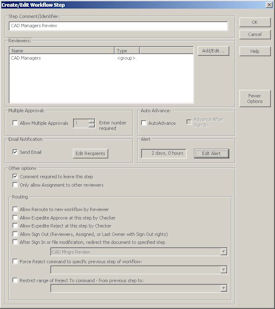Check it Out: Eliminating the ECO Ball & Chain
Latest News
July 23, 2013
 |
The change management process at a lot of engineering outfits can seem impossible to manage. The ECRs (engineering change requests) and the ECOs (engineering change orders) themselves are not usually the problem, if you forget about the fact that changes have this habit of coming in at the last minute. Rather, it’s getting everybody to approve the change both before it is made and after the do-bee engineer has done the work. This can be a slow, one-person at a time paper-pushing process where things just seem to vanish on one manager’s or the other’s desk.
Some of you may have a digital ECO process that came with your document management system. While better than pushing paper around, the processes it lays out for you can be as flexible as your grade school principal that time you set off the firecracker in the schoolyard. Setting up the ECO phase of your project can be as laborious as a Federal case. It just doesn’t do things you think it should, and it’s such a pain to use that people find inspired ways to minimize any interaction with it. And you really can’t see at a glance what’s going on, so odd errors and communication delays pop up all the time.
Whatever your beef, all you know is that you should not have to put up with a suspect, sluggish, and/or error-prone change management process any more. You have enough on your mind with clients, competitors, and CEOs dogging you. If any of that rings a bell, then you owe it to yourself to watch today’s on-demand webcast at the far side of the Check It Out link. Titled “Eliminating the ECO Ball & Chain,” this quick, 30-minute webcast is 99% demo and 100% interesting.
The basic plot line is that Synergis Software believes its way of handling ECOs can eliminate a ton of drudgery from your change management process. Rather than just say something like that, a guy named Russ Reese, a solutions engineer at Synergis, shows you how to create and manage an automated ECO process with Synergis Adept.
Reese takes you through a complete Adept ECO process using a plausible scenario. He starts with an ECR arriving and morphs it into an ECO. He continues all the way through the initial review, assignment, work review, and approval processes. As Reese sets up the ECO, he shows you how to link your ECO to all related CAD drawings and documents, creating a cogent assemblage of all project data. Tracking all ECO activity with Adept’s audit trail capabilities, working with forms and templates, and publishing final documents to every stakeholder are covered.
The automated stakeholder notification capability—and stakeholders can include third parties, BTW—seems quite handy. But Reese’s presentations on the review and approval processes are what you should find particularly interesting because these processes seem simple and straightforward. Overall, Adept’s ECO-handling procedures seem logically laid out and sufficiently flexible to bend to your needs readily and easily. The product manager’s awareness of activities seems up-to-the-minute.
Now, ECOs are almost always a drag. It’s probably fair to say that your indigestion begins at the moment your client slides you an ECR. You know the drill at your place, and you know which parts of your change management process weigh you down and burn a hole in your gut. Does Adept have a better way to handle ECOs? Judge for yourself. Take a look at this on-demand webcast from the link over there. Compare and contrast your ECO process with Adept’s.
Thanks, Pal. – Lockwood
Anthony J. Lockwood
Editor at Large, Desktop Engineering
Subscribe to our FREE magazine, FREE email newsletters or both!
Latest News
About the Author
Anthony J. Lockwood is Digital Engineering’s founding editor. He is now retired. Contact him via [email protected].
Follow DE





